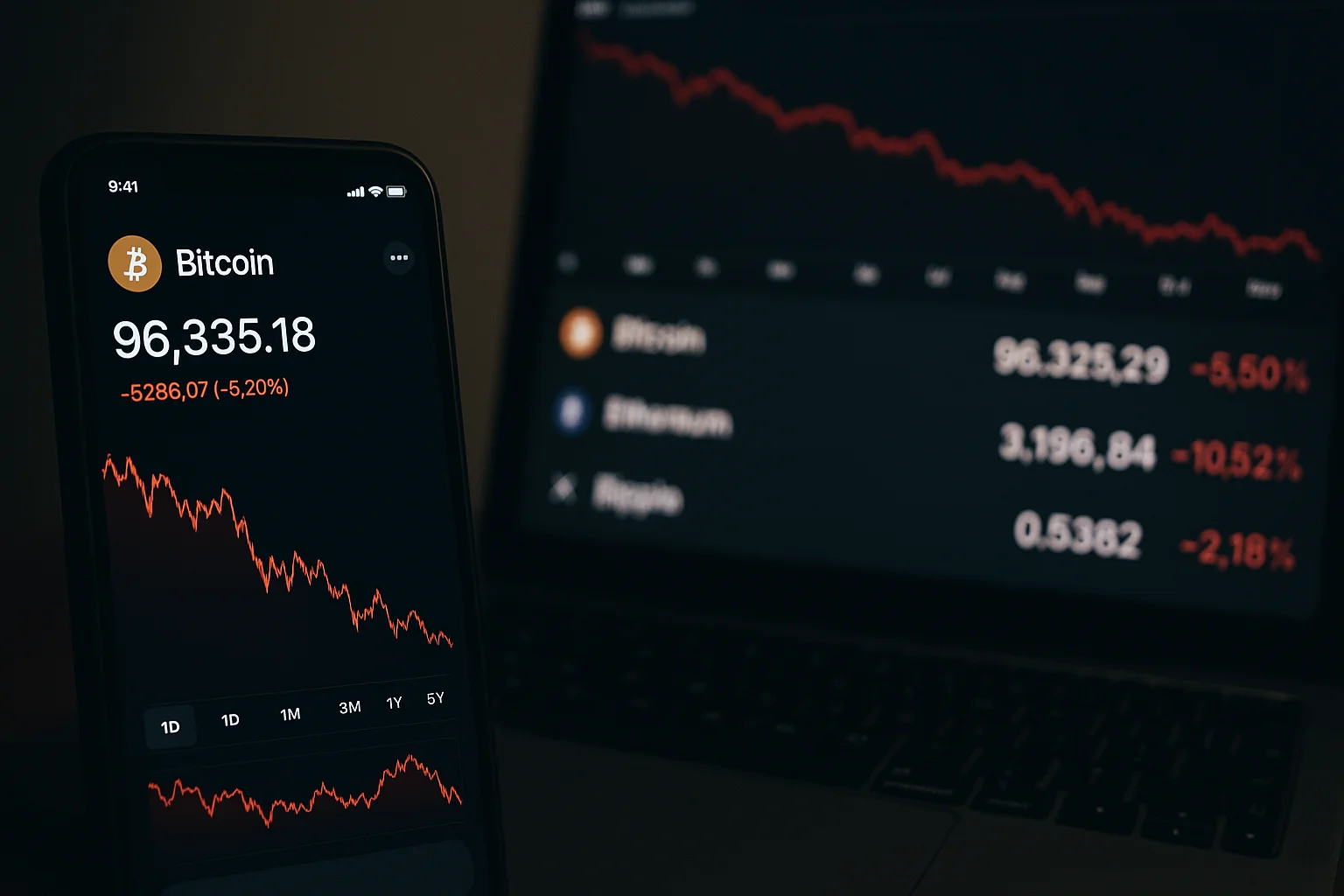News
Ethereum News
Ethereum News
Browse all Ethereum related articles and news. The latest news, analysis, and insights on Ethereum.
JPMorgan is Moving Money Market Operations To Ethereum
JPMorgan Chase is expanding its steps in blockchain-based finance and preparing to launch its first tokenized money market fund on the Ethereum network. According to the Wall Street Journal, this new product, developed by the bank's asset management arm which manages approximately $4 trillion in assets, will be offered under the name My OnChain Net Yield Fund, or MONY for short. JPMorgan plans to launch the fund with $100 million of its own capital before opening it to external investors.JPMorgan launches first tokenized money market fundMONY operates on JPMorgan's in-house tokenization infrastructure called Kinexys Digital Assets. This infrastructure allows traditional financial products to be represented on the blockchain through digital tokens. The fund will only be open to individuals and institutions with "qualified investor" status. Accordingly, a minimum investment asset requirement of $5 million is sought for individual investors, while this threshold is set at $25 million for institutional investors. The minimum investment amount to enter the fund is $1 million. Like traditional money market funds, MONY holds a portfolio of short-term, high-quality debt instruments. The fund's primary goal is to offer returns that are generally higher than bank deposits. Interest income and dividends accrue daily. Investors can participate in the fund through JPMorgan's digital investment platform, Morgan Money, and hold digital tokens representing their shares in their own crypto wallets. Another notable aspect of the fund is that transactions can be made using stablecoins in addition to cash. Investors can conduct fund entry and exit transactions using the USDC stablecoin, a dollar-pegged stablecoin issued by Circle. This approach demonstrates the increasing adoption of crypto-native payment infrastructures by regulated financial products. Such solutions, particularly those aimed at the efficient use of non-interest-bearing stablecoin balances, have long been in demand within the crypto ecosystem. John Donohue, Head of Global Liquidity at JPMorgan Asset Management, notes that there is significant interest from clients in tokenization. According to Donohue, the bank aims to make options similar to those offered in traditional money market funds available on the blockchain. This approach signals that tokenization is no longer just an experimental area but is beginning to become part of mainstream finance. This move coincides with a period in which the regulatory framework for digital assets in the US is becoming clearer. The GENIUS Act, passed this year, created a federal framework for dollar-denominated stablecoins. In addition, developments around the Clarity Act signaled a more constructive approach to which institutions will oversee blockchain-based financial products. This regulatory clarity is encouraging large financial institutions to take bolder steps in tokenizing funds, securities, and other real-world assets. Interest in the tokenization of real-world assets is rapidly increasing. By 2025, the total market capitalization of tokenized real-world assets reached a record high of $38 billion. BlackRock is the largest player in this field with a tokenized money market fund worth over $1.8 billion. Goldman Sachs and Bank of New York Mellon also announced plans to collaborate on digital assets linked to tokenized money market funds earlier this year. The Ethereum-based MONY fund demonstrates the continuation of JPMorgan's recent blockchain initiatives, as the bank recently issued a commercial bond on the Solana network for its Galaxy Digital subsidiary, using USDC in the transactions.

$4.5 Billion Worth of BTC and ETH Options Expire Today
In the crypto derivatives markets, attention is focused on the high-volume Bitcoin and Ethereum options expiring on Friday, December 12th. With a total nominal value of approximately $4.3–$4.5 billion, these options are expected to expire, creating a cautious atmosphere across the market. The approaching end of the year, weakening liquidity, and recent macroeconomic developments are causing investors to avoid taking directional positions.Bitcoin and Ethereum options expire today.According to data, approximately 39,000 Bitcoin option contracts are expiring today. The total nominal value of these contracts is around $3.6-$3.7 billion. The put/call ratio in Bitcoin options is around 1.1, indicating a slight advantage of short positions over long positions. The "max pain" level in the market is around $90,000. The current price hovering near this level suggests that the option expiration may have a limited impact on the spot market. The highest level of open interest in the options market is at $100,000. At this strike price, there are approximately $2.7 billion in open positions. Additionally, there are significant open positions totaling around $2 billion at the $80,000 and $85,000 levels. According to Coinglass data, the total Bitcoin options open interest across all exchanges has reached $54.6 billion. Deribit notes that pricing is largely stuck around $90,000 and that there is no clear directional expectation in the market. Deribit's assessment indicates that the balance between call and put options shows that investors expect limited volatility for this expiration date. It is emphasized that the market tends to maintain its current range until a new catalyst emerges. A similar picture is observed on the Ethereum front. Approximately 247,000 ETH options contracts expire today. The total nominal value of these contracts is around $768-770 million. In Ethereum options, the maximum pain level is calculated at $3,100, while the put/call ratio is fluctuating between 1.22 and 1.24. This ratio indicates that demand for selling hedging is relatively stronger on the Ethereum side as well. The total open position for ETH options across all exchanges is approximately $12 billion.Deribit analysts note that positioning in Ethereum options has shifted towards a more neutral structure, but the concentration seen in call options above $3,400 reveals that investors are willing to price in sharper price movements should volatility increase again.On the macro side, the 25 basis point interest rate cut by the US Federal Reserve this week has largely been priced in by the markets. Greeks Live analysts emphasize that it is premature to view this step as the beginning of a monetary expansion cycle. They point out that liquidity in the crypto markets has fallen to historically weakest levels as the year-end and Christmas period approach. This situation poses an obstacle to a strong and sustained rally in the short term. Looking at the spot markets, the total cryptocurrency market capitalization is hovering around $3.2 trillion. Bitcoin briefly rose above $93,000 but encountered resistance at that level and retreated back to the $92,000 range. Ethereum traded in a narrow range around $3,200 in the last 24 hours. While the altcoin market generally shows a sideways trend, limited gains were observed in privacy-focused projects such as Solana, Bitcoin Cash, Monero, and Zcash. The overall picture suggests that the market remains calm for now, despite high-volume options expiry times.

BitMine Makes New Ethereum Purchases Worth $112 Million! Tom Lee: “The Dip is Over”
The Ethereum market is once again focused on BitMine. Following increasingly optimistic statements from Fundstrat co-founder and BitMine Chairman Tom Lee in recent weeks, the company made a new Ethereum purchase worth $112 million on Wednesday. According to data from blockchain analytics platform EmberCN, based on Arkham figures, BitMine purchased 33,504 ETH via FalconX. While official confirmation is yet to come, the transaction perfectly aligns with the company's aggressive ETH accumulation strategy throughout the year. Through regular purchases, BitMine has maintained its position as the largest institutional Ethereum holder in the market and has repeatedly reiterated its long-term goal: to hold 5% of the total ETH supply by 2025. According to the company's 8-K filing dated December 7th, BitMine holds 3,864,951 ETH. In addition, there are 193 BTC, a $1 billion cash reserve, and a $36 million "moonshot" investment in Eightco Holding, which focuses on the Worldcoin ecosystem.Tom Lee reveals his Ethereum expectationsTom Lee is the clearest name behind all these purchases. Arguing that the bottom for Ethereum is now behind us, Lee said last month that ETH bottomed out around $2,500 and that he expected the price to rise to the $7,000-9,000 range by the end of January. In a more recent statement, he revealed the company's appetite by saying, "BitMine is buying twice as much ETH as it did two weeks ago."On the other hand, on the macroeconomic front, the 25 basis point interest rate cut announced by the Fed on Wednesday did not bring the expected relief in the crypto market. Powell's cautious statements about further cuts were interpreted as a "hawkish cut" and created a short-term pullback in both Bitcoin and Ethereum. Bitcoin fell as low as $90,028, a daily loss of 2.82%; Ethereum dropped 4.29% to $3,186.According to Tom Lee, these pullbacks are temporary. In an interview with CNBC, he stated that regardless of whether the Fed's current stance changes or remains unchanged, the real turnaround will come in early 2026. Lee bases his expectation on two key factors: the possibility of a new Fed chairman adopting a more dovish stance and the ISM Index, which indicates the expansion of the US economy, rising back above 50. Lee said, "Crypto prices are very sensitive to the ISM. Historically, the ISM rising above 50 coincides with the start of supercycles in Bitcoin and Ethereum."BitMine's recent acquisition is another piece of the puzzle. Despite the volatile market conditions, the company is not backing down from its long-term strategy. Overall, it seems that investors will be watching Ethereum's performance in the coming period more closely.

CFTC Launches Critical Pilot Program for Bitcoin, ETH, and USDC
The U.S. Commodity Futures Trading Commission (CFTC) has taken one of the most concrete steps toward bringing crypto assets to the center of regulated finance. The agency has officially launched its "digital asset pilot program," which opens the door to the use of Bitcoin, Ether, and USDC as collateral in derivatives markets. The program both demonstrates the regulatory body's transformation in its approach to crypto and focuses on the integration of tokenized assets into traditional finance. The announcement came from Caroline Pham, the CFTC's de facto Chair. Pham has long been a prominent figure within the agency in updating the framework for crypto assets; she previously launched the "Crypto Sprint" initiative and last week announced that Bitnomial was the first exchange to list regulatory-approved spot crypto products.Pham summarized the goal of the new program as "maintaining the global leadership of U.S. markets by embracing responsible innovation." According to her, the ability to use tokenized assets as collateral will help market participants manage capital more efficiently and enhance the real-time monitoring capacity of regulators. The pilot program is initially limited to Bitcoin, Ether, and USDCAccording to the framework announced by the CFTC, futures brokers (FCMs) will be able to accept only BTC, ETH, and USDC for the next three months. Participating institutions will report the total amount of digital assets held in their client accounts to the CFTC weekly. Furthermore, any operational issues, disruptions, or system errors that could affect digital assets used as collateral will be required to be immediately reported to the regulator.This framework allows the CFTC to monitor market behavior in a gradual and controlled manner while also generating valuable data on how the use of tokenized collateral works in practice.The CFTC also released new guidance jointly prepared by its three divisions on the same day. These guidances clarify how real-world assets, such as tokenized U.S. bonds and money market funds, are valued under the current regulatory framework. Topics such as custody, segregation, valuation shards, and operational risk have been redefined. The agency also withdrew its staff advisory, issued in 2020, which restricted FCMs from accepting virtual currencies as collateral. The CFTC stated that this guidance was outdated with the enactment of the GENIUS Act. The GENIUS Act, passed this summer, specifically sharpened the framework for stablecoin use.Strong support from the industry: "A milestone for the US"Leading figures in the crypto industry welcomed the move. Coinbase Chief Legal Officer Paul Grewal said the decision "proves once again that digital assets provide real benefits in terms of speed, cost, and risk management in payments." Circle President Heath Tarbert emphasized that the use of regulated stablecoins will improve settlement processes and support 24/7 trading.Crypto.com CEO Kris Marszalek described the decision as "a significant step toward making the US a global hub for crypto innovation." Ripple CEO Jack McDonald also stated that recognizing tokenized assets as collateral will increase capital efficiency and strengthen the competitiveness of US financial markets.

A Critical Day for Bitcoin and ETH, Worth $4 Billion
Another critical threshold is being passed in the futures and options market on Friday; contracts totaling over $4 billion in value for Bitcoin and Ethereum are expiring. Derivatives volumes have increased significantly in recent weeks, particularly in Binance futures, suggesting the market is preparing for impending volatility. Today's chart reflects both cautious and selective risk appetite.Bitcoin and ETH options expiringAccording to Deribit data, the total notional value of BTC and ETH options expiring today is around $4.07 billion. Bitcoin accounts for $3.4 billion of this. Total open interest stands at 36,906 contracts. The Put/Call ratio for Bitcoin is 0.91, meaning there are slightly more put options than calls in the market, suggesting a balanced, slightly defensive position. The "maximum pain" level for BTC is $91,000; if the price approaches this level, most contracts are expected to expire worthless. Bitcoin is currently trading slightly above this level. There's clearer optimism on the Ethereum side. The notional value of ETH options expiring today is $668.9 million. Open interest stands at 210,304 contracts. The put/call ratio is 0.78, meaning demand for call options on ETH is stronger. The maximum pain point is at $3,050, slightly below the current price. This ratio and price structure suggest a more positive outlook for Ethereum compared to Bitcoin in the short term.Today's expiration represents much smaller volume compared to last week. During the massive event on November 28th, over $15 billion worth of BTC and ETH options expired, meaning the current contract volume is less than a third of that day. This is due to institutional investors increasingly expanding their positions over longer periods. In Bitcoin, in particular, there's a significant accumulation of call options with expiration dates extending into mid-2026. This trend is consistent with institutional views that interest rate cut expectations, ETF demand, and liquidity conditions will be more supportive next year.Derivatives analysis platform Laevitas highlights the steady increase in open interest in recent weeks, highlighting fresh capital inflows into the derivatives market. This suggests investors are preparing for a multi-quarter recovery. As professional movements gain traction, price discovery in the market becomes more systematic.However, the short-term outlook remains mixed. Greeks.live's December 2nd update describes the market as "cautiously optimistic." Analysts say investors are searching for a bottom, but volatile price movements are eroding confidence. The put skew, in particular, remains elevated, meaning the market continues to price in short-term downside risk. Because the sharp moves in February are still fresh in memory, many professionals are avoiding "chasing calls on dips."Amidst this uncertainty, another significant shift is the cooling of volatility. While volatility in Bitcoin has tightened, ETH options have become relatively more attractively priced. This is leading some to turn to Ethereum. Institutional investors are focused on capital preservation and generating sustainable returns rather than seeking quick profits. Deribit also notes that the general trend is toward "controlled and rational strategies rather than chasing 5-10x returns."

Fusaka Launched on Ethereum: What Changed?
Ethereum has completed its second major network upgrade of the year, activating the Fusaka update on the mainnet. This 17th major update, following Pectra, launched approximately seven months ago, marks a new era in the network's scaling roadmap. The most notable innovation is the data sampling system called "PeerDAS." This technology fundamentally updates Ethereum's data availability architecture and significantly expands the capacity of the rollup ecosystem.PeerDAS, a new era in blob capacity and L2 costsFusaka went live at block number 18,200,000. After weeks of testing on the Holesky, Sepolia, and Hoodi testnets, the teams completed the final preparations. Immediately after the activation, the Ethereum price fluctuated between $3,150 and $3,210, with volume rising from $28.2 billion to $32 billion within six hours. Santiment data indicates a strong accumulation from "shark" wallets holding between 1,000 and 10,000 ETH. PeerDAS, at the heart of the update, allows each node to retain only samples of the data blob without downloading it. This approach reduces bandwidth overhead and paves the way for an approximately eightfold increase in blob capacity. Ethereum developers say PeerDAS is the practical embodiment of the long-planned "sharding" vision. Vitalik Buterin particularly emphasized this point, saying, "The sharding model envisioned since 2015 is finally operational."Fusaka's Blob Parameter Only (BPO) mechanism is also noteworthy. Thanks to this system, blob capacity can be increased without requiring a full hard fork. By January, blob targets are planned to be increased to 14, and the upper limit to 21. The "blob fees approaching zero" issue seen after the Dencun pandemic is being addressed with base fee adjustments and a new pricing model. This will create more predictable costs for rollups, and a gradual increase in the ETH burn rate is also expected. The update brings a series of infrastructure improvements not only on the data side but also on the security and UX side. The adjustment to the gas limit cap reduces DoS risks by preventing a single transaction from consuming the block transaction fee (gas). Native support for the SECP256R1 curve accelerates device-based signature and passkey integrations. EIP-7939, which improves zero-knowledge tools, also points to Ethereum's long-term resilience and post-quantum security goals.Industry players agree that Fusaka is an "infrastructure-driven transformation." Institutions like Alchemy, Boundless, and Sygnum Bank state that this update will reshape the rollup economy, creating more regular batch releases, a more stable L1 cost structure, and broader validator participation. The emphasis on predictability, particularly for enterprise tokenization projects, is particularly prominent.The Ethereum Foundation aims to release major updates twice a year from now on. Researchers have already begun work on the next major update, "Glamsterdam," planned for 2026. The effects of Fusaka will become more apparent in the coming months with the increase in network capacity and the decrease in L2 fees.Following the developments, the ETH price rose by almost 5 percent and rose above $3,200.

European Giant Chooses Ethereum for Fund Tokenization
Amundi, Europe's largest asset manager, has taken a major step forward, bringing together traditional finance and blockchain infrastructure, by launching the first tokenized share class of its money market fund on Ethereum. The giant, which manages approximately $2.3 trillion in assets, aims to both digitize fund distribution and expand investor access with this move.The company announced that the new share class, "J28 EUR DLT," for its Amundi Funds Cash EUR money market fund is now registered on Ethereum. This structure allows ownership, movements, and transaction history of fund units to be tracked on-chain, providing investors with a more transparent and faster transaction experience.CACEIS, one of Europe's leading custody and transfer agencies, is providing the technical infrastructure for this transformation. The institution is developing digital wallets for the fund, a 24/7 blockchain-based ordering platform, and automation systems for subscription and redemption transactions. CACEIS CEO Jean-Pierre Michalowski states that their goal is to “enable 24/7 access to investment funds through stablecoins or future central bank digital currencies.”On the Amundi side, this step is seen as a concrete part of the company's long-term digital asset strategy. Jean-Jacques Barberis, Head of Institutional Clients and ESG, emphasizes that asset tokenization will accelerate globally, and that Amundi will be preparing for new initiatives in this area both in France and international markets.The new model does not completely change the traditional distribution network; investors can continue to receive funds through existing banking channels. The tokenized share class on Ethereum has been added as an additional option, creating broader access for both institutional investors and professionals in the digital asset ecosystem.Tokenization Draws AttentionWhen it comes to why tokenization is so popular, the numbers speak for themselves. By 2025, the total market value of real-world assets on-chain increased from $15 billion to over $37 billion. While Provenance Blockchain holds the lead in this space, Ethereum is a strong second with $12.4 billion in tokenized RWA. Furthermore, the growth of giants like BlackRock's BUIDL fund and Franklin Templeton's money market fund on Ethereum places the network at the center of institutional tokenization.Amundi's move demonstrates that this trend is only just beginning. Europe's largest asset manager's choice of Ethereum both strengthens the legitimacy of tokenization in the continent's regulation-driven financial world and solidifies Ethereum's leadership in the RWA segment.Ultimately, this initiative lays the foundation for an infrastructure accessible 24/7, enabling automated transactions in the fund world.

A Critical Day for $16 Billion in BTC and ETH Options
It's one of the busiest days of the year in the crypto derivatives market. According to Deribit data, over $16 billion worth of Bitcoin and Ethereum options are reaching maturity on October 31, 2025. Both BTC and ETH are experiencing a massive position closure, paving the way for sharp intraday price fluctuations.$100,000 Critical for Bitcoin OptionsMore than 145,000 contracts are expiring on the Bitcoin side with a notional value of approximately $13 billion. The market is trading around $91,000, but the maximum pain level is $100,000. In the options market, the maximum pain level refers to the price range where the greatest investor losses occur at expiration, and prices are frequently observed retreating towards this level. Therefore, upward pressure is likely to be felt as the price approaches expiration. According to Deribit's analyst team, the sharp pullback in recent weeks has significantly reshaped BTC options positions. As Bitcoin fell from $126,000 to the $80,000 range, many investors holding long puts took profits. Despite this, a significant portion of investors remain cautious; put positions held in the $80,000-$85,000 range remain on the table.Another factor closely watched by the market is the large-sized call condor strategy launched for the "year-end bull run." Analysts note that this structure, approximately $6.5 million targeting the $100,000-$106,000-$112,000 range, was the most dominant trade throughout the week. This structure points to the expectation of a strong upward movement in Bitcoin at the end of the year.On the other hand, the persistent use of call overwriting strategies (i.e., investors selling calls at high strike prices against their holdings of BTC) is somewhat dampening the upside potential. This situation has led to a slight softening of implied volatility (IV) and suggests that the market has not yet committed to a one-way trend. On the Ethereum side, 574,000 contracts with a nominal value of approximately $1.7 billion are closing today. ETH is trading around $3,000, with maximum pain at $3,400. The put-call ratio, at 0.48, suggests a call bias, similar to Bitcoin. However, ETH's positioning isn't as aggressive as BTC's; it's more balanced and less bearish.Market volatility is higher for both assets compared to the previous month. Bitcoin's IV average for major futures is around 45%, while Ethereum's is just below 70%. The main factors fueling this volatility are increasing macro uncertainty in the last quarter, the three-month price pressure, and the divergence among investors regarding direction. Analysts reiterate the need for caution in leveraged trading.Today's major expiration close could lead to increased volatility. A price move toward Bitcoin's maximum pain level, or conversely, a sharp increase in volatility, could rapidly alter liquidity conditions for both BTC and ETH for the remainder of the day. In short, the market is experiencing a two-way tension, caught between strong year-end expectations and short-term caution.

BitMine Makes Huge Ethereum Purchase: Target Set at $9,000 by Early 2026
While the crypto market has undergone a sharp correction in recent weeks, large-scale institutional purchases continue to attract attention. Most recently, BitMine Immersion Technologies reportedly purchased 14,618 Ethereum (ETH) on Thursday. Using Arkham Intelligence data, Lookonchain reported that the transaction was conducted through BitGo's "0xbd0...E75B8" wallet for approximately $44.34 million. While there has been no official confirmation from the company, the purchase has generated significant market interest. BitMine's move follows the giant's $200 million ETH purchase just a few days earlier. According to the company's latest official statement, BitMine holds 3,629,701 ETH in its treasury. This amount equates to approximately $10.9 billion and represents approximately 3% of the total Ethereum supply. BitMine has long emphasized its goal of reaching 5% of the total supply and has expressed its belief that Ethereum's importance in financial markets will continue to grow. The company's chairman, Tom Lee, is known for his strong support for Ethereum. He has previously stated that Wall Street and even the White House will be more receptive to Ethereum in the future because the network is a "truly neutral" blockchain. According to Lee, Ethereum will become an integral part of corporate infrastructure with the proliferation of smart contract-based solutions in financial services.$7,000-$9,000 ETH PredictionWhile the crypto market has been under pressure in recent weeks, Tom Lee believes a new bullish period is imminent. In a podcast interview, Lee stated that the price of Ethereum bottomed out around $2,500 and that he expects ETH to rise to the $7,000-$9,000 range by the end of January 2026.A few days ago, Lee told CNBC that the US Federal Reserve would adopt a more dovish stance towards the end of the year. He believes that clarification of the Fed's statements on interest rate policy and inflation will reduce investor pressure. He argues that this environment could pave the way for a strong rally for both Bitcoin and ETH. Lee even stated that Bitcoin could surpass $100,000 by the end of the year and even reach a new high.According to market data, Bitcoin is currently trading at $91,309, posting a limited daily increase of 0.13%. Ethereum, on the other hand, is down 0.69% in the last 24 hours, reaching $3,018.BitMine's massive purchases indicate that institutional investors continue to expand positions during downturns. This, combined with the expected macroeconomic easing in 2025 and 2026, could create a strong medium-term story for Ethereum. The company's target of reaching 5% of the market's supply remains a topic to be closely monitored in terms of both liquidity and institutional demand.

Vitalik Buterin's Quantum Warning: "Prepare Ethereum"
The long-discussed quantum threat on Ethereum is no longer a technical possibility but a timely warning. Ethereum co-founder Vitalik Buterin, appearing on the DevConnect stage, stated that the acceleration of quantum computer research could weaken the existing cryptographic infrastructure and emphasized that the ecosystem must strengthen its defenses "within the next four years."Buterin's message was clear: This isn't an abstract security debate; it's a technical alarm directly concerning Ethereum's future and the integrity of user assets. He even linked the timeline to the 2028 US presidential election, laying out a goal that aligns with global political and technological agendas.Why is current cryptography risky compared to quantum?Ethereum currently uses elliptic curve cryptography for transaction verification, account security, and signature verification. This method is quite secure for classical computers. However, a quantum machine with sufficient scale can use Shor's algorithm to derive a user's private key from their public key. This makes not only wallets but also a wide range of applications, from smart contracts to Layer 2 infrastructure, vulnerable. Buterin stated that the real danger should begin "before quantum supremacy is declared," and that Ethereum should move with a planned transition, not panic. Forcing hasty updates to the protocol could lead to both structural errors and a chain split.How will the transition occur? A clear four-year timeframeButerin stated that Ethereum should complete the transition to quantum-resistant cryptography within a roughly four-year timeframe. This approach provides developers with a reasonable time to test and implement new algorithms and manage the user-side transformation.However, this process doesn't solely fall on the shoulders of core developers. The entire ecosystem, from exchanges and wallet developers to L2 teams and enterprise infrastructure providers, requires coordinated action. Given Ethereum's massive technical and economic network, a cryptography migration of this scale requires significant engineering effort.Where should innovation shift?Buterin stated that frequent changes to the core protocol are risky, and that innovation should now be focused more on Layer 2 platforms, smart wallets, and privacy tools. This approach aligns with Ethereum's long-term strategy of keeping its core more stable while leaving experimental and rapidly developing features to the upper layers.Rollups and other L2 solutions stand out as areas that improve the user experience and provide a suitable environment for testing new cryptographic structures. This allows for the development of nascent technologies without threatening the stability of the underlying protocol.Wallets and privacy tools will be at the forefrontWallets will be the most acutely felt part of the transition. Users will need to migrate to new signature schemes, update their addresses, and perform key rotations. For this transition to be seamless, an interim period where wallets simultaneously support both classical and quantum-resistant algorithms is essential.Similarly, privacy-focused solutions must integrate new cryptographic standards to prepare transaction data and identity information for the post-quantum era.

ETH Comment and Price Analysis - November 19, 2025
ETH Technical Analysis ETH Critical Zone Analyzing the chart on the daily time frame, we see that ETH has pulled back exactly into the expected zone on the daily chart. This zome refers to the 0.618–0.66 Fibonacci band. This area has acted as a strong demand zone in past moves and has often been the starting point of major reversals. The price is currently sitting right on this band, and we can see an effort to hold this level.The RSI is also approaching oversold territory, showing that selling pressure is weakening and downward momentum is losing strength. When we combine these signals, it’s clear that ETH is at a level that is very suitable for a potential bounce.Short-term outlook is straightforward:As long as ETH stays above $2,925 (the 0.618 level), the chance of a recovery remains strong.If an upward reaction comes, the first target is $3,235.After that, the $3,578 – $3,708 zone stands out as the main resistance area. A breakout above this range could trigger a renewed bullish momentum.In the downward scenario:The $2,822 – $2,526 range (0.66–0.79 Fibonacci band) is the final retracement zone.Even if ETH drops into this area, the larger trend structure would still remain intact.ETH has reached the most critical zone of its Fibonacci correction. A strong green candle from this region could clearly signal the start of a short-term recovery.These analyses, not offering any kind of investment advice, focus on support and resistance levels considered to offer trading opportunities in the short and medium term according to the market conditions. However,t raders are responsible for their own actions and risk management. Morover, it is highly recommended to use stop loss (SL) during trades.

Sharp Crypto Market Drop: Bitcoin and Ethereum ETFs See Record Outflow
The crypto market had an extremely rough start to the week. As of Friday morning, all major assets, especially Bitcoin and Ethereum, experienced strong selling pressure; ETF data further darkened the picture. While Bitcoin ETFs and Ethereum ETFs experienced one of their worst days in history, the XRP ETF bucked the trend by recording surprisingly strong inflows around the same time.According to Coinglass data, spot Bitcoin ETFs saw $866.7 million in outflows in one day. This figure marked the third-largest net outflow since the ETFs' launch. Ethereum ETFs were even more striking, with $410 million outflows in a single session. Even the selling pressure generated by October's high volatility couldn't reach these levels.The outflow wave, led by the market's largest ETF providers like BlackRock and Fidelity, demonstrates a significant risk aversion among institutional investors. ETF data is no longer just a market detail; it has become one of the most powerful indicators of the crypto ecosystem's overall risk appetite. Therefore, each new breakout signals a deepening market fragility.Macro pressures hit all risky assetsThe crypto sell-off wasn't solely driven by internal market factors. US stock markets also experienced their worst day in a month. The mass sell-off in technology stocks, in particular, accelerated as investors grew increasingly concerned about the high valuations of AI companies. The uncertainty surrounding the economic outlook and the weakening of interest rate cut expectations further exacerbated the situation.In this atmosphere, appetite for risky assets abruptly diminished; the crypto market is typically one of the most severely affected during such periods. Under this pressure, Bitcoin fell below $100,000, losing its psychological threshold and was trading around $97,000 at the time of writing. The Crypto Fear and Greed Index also fell sharply, falling into the "extreme fear" zone.What does the technical outlook suggest?Bitcoin closed the week with a loss of over 5%, while technical indicators confirm the dominance of sellers. The RSI of 35 suggests the market is still trading in a strong selling zone. If Bitcoin closes below the $97,460 support, analysts predict the price could weaken to the $95,000 range. The outlook for Ethereum is also weak. After rejecting the broken trendline resistance at $3,592 earlier this week, ETH has lost nearly 10% in three days and retreated to the $3,200 region. If ETH loses the $3,170 support, analysts predict a new correction toward the $3,017 region.

$5.4 Billion in Options Expiration on Bitcoin and Ethereum: Markets Hold Their Breath
The crypto market is preparing for a new turning point with $5.4 billion in Bitcoin and Ethereum options expiring today on the Deribit exchange. This massive expiration is a critical test that will determine both price volatility and investor behavior. Bitcoin is trading around $102,000, while Ethereum is trading sideways around $3,350.In the options market, attention is particularly focused on Bitcoin's "max pain" level of $107,000. This level represents the price range where the majority of investors incur the most losses. Meanwhile, $3,800 stands out as a similar psychological and technical resistance for Ethereum.Traders are cautious, but still betting against volatilityAt a time when analysts are warning of "end-of-cycle signals," it's noteworthy that traders are trying to suppress volatility with short positions. An analysis by Greeks.live indicates that many investors continue to sell options, focusing on the ETH 3,650, 3,400, and 3,800 levels. These strategies are based on the expectation that the market will remain stable; however, it also emphasizes the potential for significant losses if prices suddenly break out. Open interest in Bitcoin options has reached 45,802 contracts. Of these, 25,570 are calls and 20,233 are puts. The total open interest exceeds $4.6 billion. This suggests that investors are still actively holding positions despite the uncertainty in the market.The defensive line for Ethereum is $3,800The outlook for Ethereum options is slightly more cautious. The put/call ratio is at 0.9, suggesting a balanced but defensive outlook. The largest open interest is concentrated in puts at $3,500 and calls at $4,200. This strengthens the possibility that the price will move within this range in the short term. According to data, the total open interest in ETH options on Deribit reaches $713 million. Traders often attempt to limit downside risk and capitalize on potential upsides with complex strategies such as "calendar spread," "risk reversal," and "straddle."Macro pressures persistThis critical juncture in the options market is compounded by increasing macro pressures. Recent US inflation data (CPI) and statements by Fed Chair Jerome Powell have weakened ETF inflows. Despite this, the high open interest rate in the options market suggests that investors are still determined to remain in the market.The general market sentiment can be described as "cautious optimism." While increased volatility is expected in the short term, the majority of traders believe prices will not fall below $100,000. However, if volatility surges after expiration, sharp price movements in the crypto market may be inevitable today.

ETH Comment and Price Analysis - October 31, 2025
ETH Technical AnalysisEthereum is experiencing renewed activity. As on-chain transaction volume and tokenization projects grow, year-end ETH price predictions have been revised upwards. Standard Chartered announced a target of $7,500 by the end of the year. Furthermore, the Fusaka update, expected to go live in December, will further increase the network's efficiency. In light of all these developments, let's take a look at the technical outlook for ETH's price. Falling Channel Formation Analyzing the chart on a daily time frame, we can clearly observe that Ethereum is still trading inside a falling channel. The $3,578–$3,708 range stands out as a strong horizontal support zone, and the price is currently trying to hold around this key intersection where the lower channel meets this support. A rebound toward the channel’s mid-line remains likely as long as ETH stays above $3,578. The first resistance level is $3,708, followed by a stronger barrier around $4,143, which aligns with the channel’s upper zone. If this level is broken with volume, ETH could extend its move toward $4,551.However, losing $3,578 could trigger stronger selling pressure, pushing the price down toward $3,235, where the lower channel support and a key horizontal level align.Support & Resistance LevelsSupport levels: $3,708 – $3,578 – $3,235Resistance levels: $3,800 – $4,143 – $4,551 – $4,956Summary:ETH is testing a critical support zone. Holding above $3,578 keeps the recovery potential alive, while a breakdown below this level may open the door to a deeper correction toward the lower channel.

$17 Billion in Options on Bitcoin and ETH Expires Today
The crypto market is preparing for one of the largest derivatives transactions of October. Bitcoin (BTC) and Ethereum (ETH) options contracts, with a total value approaching $17 billion, will expire on Friday, October 31, 2025, on the Deribit exchange. According to Deribit data, Bitcoin accounts for $13.5 billion of the expiring contracts, while Ethereum accounts for $2.5 billion. This volume surpassed last week's $6 billion weekly close, making October one of the most active periods of the year.Cautious Optimism on BitcoinBitcoin's price was trading around $109,000 at the time of writing. There are more than 124,000 Bitcoin options contracts expiring, and the "max pain" level, or the price point where the greatest loss occurs, is set at $114,000. Historically, the Bitcoin price tends to trend toward these levels as expiration approaches. This is because market makers adjust their positions accordingly to hedge against these levels. The put/call ratio is hovering around 0.70, indicating that investors are not overly pessimistic but rather cautiously optimistic. However, market data indicates that the market is "fragile," and selling pressure may increase in areas below $112,000. The $106,000 support level is considered critical in the event of a potential decline.Ethereum Takes a More Cautious StanceOn the Ethereum side, more than 646,000 options contracts are set to expire on Friday. Total volume is $2.49 billion. The "maximum pain" level is set at $4,100, just above the current price. While Ethereum's put/call ratio is also 0.70, traders are generally more cautious. Deribit analysts commented, "Ethereum positions are cautiously optimistic. However, investors are still hedging against a potential downside." The number of open interest on the ETH side has fallen to around 70,000 in the last month, indicating a decline in trader interest. This strengthens the possibility of a period of sideways movement or consolidation in the market.Macro Trends and ExpectationsAnalysts note that the easing of trade tensions between the US and China has increased risk appetite, but markets remain cautious. The Deribit team warned, "While the overall macro outlook is turning positive, market participants should be prepared for a potential increase in volatility." This $17 billion maturity event could determine the short-term direction of Bitcoin and Ethereum prices. The maximum pain levels of $114,000 (BTC) and $4,100 (ETH) could cause prices to temporarily retreat to these levels. However, if no new catalysts emerge, a period of directionless consolidation is also possible in the market.At the time of writing, Bitcoin is trading around $109,500, while Ethereum is trading around $3,800.
